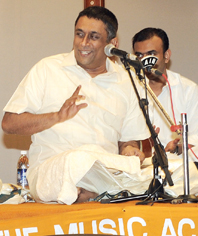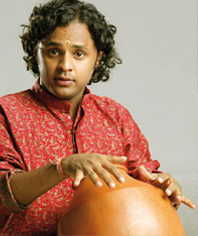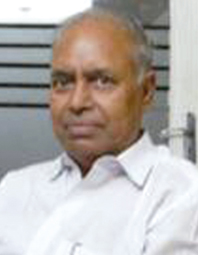SEASON 2011-12 - A random tour and some random thoughts - T.T. Narendran

My ‘season’ began as early as 21 November at Nada Inbam. Palakkad Ramaprasad, grandson of Palghat Mani Iyer, was on stage with Kumbakonam M.R. Gopinath and Ashok Kalidas. This doctorate in economics from Georgia is blessed with a genuine baritone voice that makes an instant impact on the listener. Steeped in classical values, he simply needs to learn “kutcheri-craft” a little more. He sang a good Poorvikalyani alapana and a pleasing Ninnuvinaga maridikkevarunnaru of Syama Sastry. In another concert at Sastri Hall he sang Devagandhari (Enneramum) and Vasanta (Ma dayai) impressively.
By 29 November, when I went to listen to Rithvik Raja, Bharat Kalachar was already entrenched into ‘season 2011’. This youngster, among a few that have taken music as their profession, has been rising steadily over the last couple of years. Here and elsewhere that I heard him, he sang Todi and Varali impressively at different concerts. He sings niraval well and excels in ragam-tanam-pallavi. What he needs are better presentation skills, poise and a little more power while finishing off fast paced niraval-s or swara-s.
The very popular Abhishek Raghuram was featured at several sabha-s. At his concert for Brahma Gana Sabha he showcased all his positive qualities well – voice, range, speed, mobility and grip over laya. What did not go too well was his scale-based elaboration of Poorvikalyani, which displayed virtuosity at the expense of the melodic identity of the raga. Anantha R. Krishnan (formerly A. Anand) on the mridanga, was an enthusiastic partner in the proceedings, which also had B.U. Ganesh Prasad (violin) and K.V. Gopalakrishnan (khanjira) providing good support.
SPOTLIGHT - GIRIDHAR UDUPA - VEEJAY SAI

It was the summer of 2004. Far away in Reunion Island, off the Mauritius coast was one of the biggest music festivals in the world. Artists from all over flocked to showcase their talent. The violin maestro Dr. L. Subramaniam was also invited with his entourage of artists. Giridhar Udupa who took a flight from Bangalore to the venue via Mumbai was excited to be a part of this international summit. As he checked out of the airport with his baggage and into the plush venue, he got the biggest shock an artist could get. He opened his baggage to find his instrument shattered to pieces, because of the rough handling of baggage in transit at airports. He sought help from every possible artist he could. But far away, in that part of the world, there was almost no hope of finding his instrument, or even a remote replica of it. As news of this mishap spread amongst the artist community, all that little Giridhar could do was to sit back panic stricken and make a silent prayer. “I probably put in the prayers of my lifetime which I never did before, like investing all the punya of your deeds of a lifetime”, he says. Someone told him that a Tamil-speaking family in that island had a similar instrument, but with a big fat crack running right across its body. “I knew that a certain gum could do the trick of fixing the instrument. So I tried it”, recollects Giridhar with the same amount of anxiety in his eyes, almost half a decade later. “And it worked! It also matched the right pitch of the great maestro’s violin! I couldn’t believe myself. Added to this, an artist who was touring around came forward to donate his instrument on seeing my plight. To my surprise that too had the same pitch,” recollects Giridhar.
That was one of the memorable concerts by Dr. L. Subramaniam on the violin and Giridhar Udupa on the ghatam. “I think it was the blessings of my guru-s and God that I was lucky enough to overcome such a trauma”, he adds with a sigh of relief.
FIRST PERSON - Spic Macay A partial success

Subramaniam Swaminathan retired in 2000 as professor of mechanical engineering from IIT Delhi, where he served for more than three decades. An expert on several aspects of Indian culture and heritage, Swaminathan coordinated SPIC MACAY concerts within IIT Delhi for several years. He is the author of the illustrated book, Mahabalipuram, Unfinished Poetry in Stone and a founder of the Tamil Heritage Group in Chennai.
Kiran Seth was four years my junior in the faculty at IIT Delhi. The son of a mathematician, Kiran is a brilliant mathematician, too, specialising in Industrial Engineering. We all know that he was inspired by a dhrupad concert by the Dagar Brothers while he was a Ph.D. scholar in the US. He plunged into the mission of taking Indian classical music to young people while he was on the faculty of IIT Delhi.
Kiran was very good at creating a buzz about classical music, making it fashionable to go to concerts at a time when young people were generally embarrassed to be even seen at such events.
For more on SPIC MACAY read Sruti magazine
HERITAGE - Music and dance in Chalukya sculptures - CHITHRA MADHAVAN
The Chalukyas who ruled from the 6th to the 8th centuries AD were, like the Pallavas and the Pandyas of the Tamil country, great patrons of the fine arts, especially music and dance. At the same time, the Chalukya rulers were also interested in experimenting in temple art and architecture. Both these facets are clearly reflected in the sculptures adorning the walls of the temples they built in Karnataka.
The sleepy town of Badami (Bagalkot district, Karnataka) was once the famous bustling Chalukyan capital, then called Vatapi. Abounding in sandstone, Badami has as many as four cave-temples, created by the architects and sculptors of the 6th century AD. Of these, Cave One, dedicated to Siva has, near the entrance, an excellent stone sculpture of this deity’s manifestation as Nataraja. Sixteen-armed and 1.5 metres in height, this carving captures your attention. Next to Nataraja is a small dancing image of Ganesa as also a bhakta playing a vertical drum and Nandi standing by the side. Some of the cave temples also have rows of Sivagana-s – fat and short, dancing joyously.


